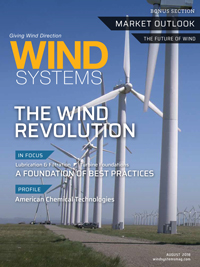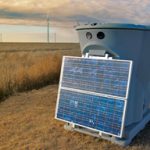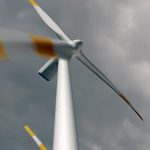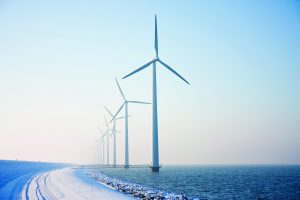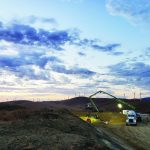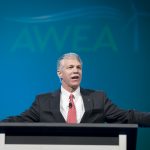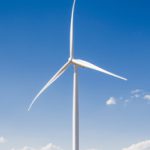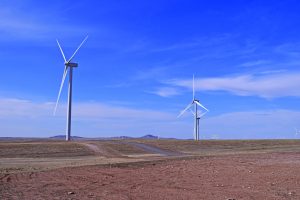t turns out that tapping into a free and abundant natural resource that exists everywhere is among the cleanest and most efficient ways of producing electricity. Investments and innovations over the past decade have brought wind’s costs down to their lowest levels ever — 66 percent cheaper than in 2009 — making wind power a mainstream source of reliable, affordable energy.
Over the past five years, the United States has more than tripled its wind-generating capacity, with wind representing 25 percent of new power generating capacity that came online. Wind also surpassed conventional hydropower as the largest renewable energy source by capacity.
Recent market trends show this impressive growth should continue in the years ahead, as wind has become the cheapest source of new electricity in many parts of the country.
Continued technological and manufacturing improvements also allow new turbines to reach stronger, steadier winds, meaning more electricity can be generated at a lower cost. As we continue adding new chapters to this American success story, let’s take stock of the state of U.S. wind power.
All In For Wind
Utilities and Fortune 500 companies continue to show a strong appetite for wind. Their demand has helped grow the number of new wind projects under construction or in advanced development 40 percent since this time last year.
In 2017, the industry added 7,017 MW of new capacity across 24 states, enough to power millions of homes. Forty-one states now have utility-scale wind projects, and by the end of the year, the U.S. had enough installed wind capacity to power the equivalent of 27 million American homes.
Overall, wind now supplies more than 6.3 percent of America’s electricity. However, figures are even more impressive at the state level. Iowa, Kansas, South Dakota, and Oklahoma now all generate at least 30 percent of their electricity using wind. In total, 14 states generate at least 10 percent of their electricity with wind.

Though Texas remains the country’s largest wind producer, New Mexico has made headlines by tapping into its large and abundant wind resources. In 2017, it had the highest rate of new wind-power growth in the country, putting the Land of Enchantment on pace to join the ranks of other wind powerhouses.
“I’m proud that New Mexico’s wind power capacity grew at a faster rate than any other state and generated an unprecedented level of private sector investment and job growth,” said U.S. Senator Martin Heinrich. “As consumers and major companies demand cheaper and cleaner power sources, our state stands to benefit and become an even bigger leader in this booming energy sector — especially in rural communities.”
In many states like New Mexico, wind offers new job opportunities and much-needed tax revenue that helps revitalize rural communities. It has not only allowed communities to profit from the passing breeze but has also done so in a manner that leaves 98 percent of the land undisturbed, so that it can remain useful for farming, ranching, or natural-habitat preservation.
Fortune 500 companies have also recognized the benefits of wind power. Many of them have committed to procuring wind energy for their energy-intensive manufacturing and data center operations. To guarantee a reliable and price-stable supply of renewable energy, many companies have entered into power purchasing agreements (PPAs). PPAs allow companies to contract with a wind-energy provider to buy electricity over a specified period of time at a fixed rate.
In fact, corporate buyers account for 94 percent of total non-utility wind deals. In 2017, companies contracted for more than 2,000 MW of wind energy. This helps them plan for the long term while also reaching internal sustainability goals.
“Helping to grow the renewable energy market is not only good for the environment, it is a strategic business move as we strive for long-term sustainability,” said Anheuser-Busch CEO Joao Castro Neves.
Already in 2018, companies such as Nike, T-Mobile, Facebook, and Bloomberg have entered into new agreements to buy wind power. The complete list includes first-time wind buyers such as Adobe Systems, AT&T, Brown Forman, Kohler, and Nestlé. Every month, the list of companies that have committed to buying wind gets longer.
“As one of the world’s largest companies, we know how we source our energy is important,” said Scott Mair, president of AT&T Operations. “Many companies are focused on their own carbon footprint, but we believe our industry can do more. We’ve been working for a long time to ensure our wind projects deliver for both our business and the environment.”
Corporate procurement and PPAs will continue to play an important role in wind’s growth in the coming years.
2018 has seen a healthy start, with non-utilities accounting for nearly a third of PPAs. During the first quarter of this year, project developers have signed more than 3,560 MW of PPAs. That makes Q1 the strongest quarter for PPA growth since AWEA began tracking it.
The Promise of Offshore
While land-based wind continues to expand, the U.S. is also on the cusp of developing more offshore capacity. The development of offshore wind in the coming years represents billions of dollars of investment and thousands of new manufacturing and shipping jobs. Offshore wind farms offer the promise of efficiently providing electricity to major population centers along the coast, allowing us to tap into a new ocean energy resource. Offshore wind is a proven technology that holds enormous potential for the United States.
“The European offshore wind market is 27 years old,” said Roy Francis, vice president of Business Development for Gulf Island Fabrication, a Texas-based offshore energy construction firm. “We are taking the best from the mature European industry and pairing it with American know-how.”
Because of the success at the Block Island Wind Farm, America’s first offshore project, states are looking to tap into vast wind resources off the coast. By the end of 2017, there were already 17 offshore wind projects in various stages of development, spanning 11 states off the East, West, and Great Lakes coasts. These new offshore projects represent more than 11,600 MW of wind-power development.
Many states are looking to offshore wind to secure affordable energy, achieve renewable goals, and reduce carbon pollution. For example, Massachusetts utilities intend to procure 1,600 MW of offshore wind by 2027. New Jersey has also launched massive plans to develop more than 3,500 MW of offshore wind by 2030.
Other projects also are coming along. In 2017, Maryland’s Public Service Commission awarded Offshore Renewable Energy Credits (ORECs) to U.S. Wind and Deepwater Wind, which together will produce more than 368 MW.
New York also has announced ambitious plans to develop up to 2.4 GW of offshore wind over the next decade to help meet its goal of 50 percent renewable energy by 2030. The state released its Offshore Master Plan in January, which identifies areas for wind development and potential pathways to procurement. New York also intends to hold two requests for proposals (RFPs) over the next two years to launch development. On top of that, New York will invest $15 million in education programs to train workers for offshore wind jobs and developing its port infrastructure.

Offshore is a new frontier for the American wind industry, and it promises to support thousands of new manufacturing and shipping jobs across the country. This is only the beginning of the country’s ability to tap into the strong and steady winds off our coasts.
A Confident Industry Works for America
As interest from utilities and companies steadily increases and technological advances continue to drive down costs, American wind power will keep growing. And that means more benefits for local communities in farming and factory towns that need new opportunities.
American wind power invested $14 billion in new wind projects last year, and farmers and ranchers hosting turbines on their property received $267 million in lease payments in 2017 alone. Added wind revenue for local budgets also lessens the tax burden on many host communities, helping them pay for school improvements, road repairs, and law enforcement.
Every community has a story. For example, Nolan County, Texas, about 190 miles west of Fort Worth, has increased its taxable value five-fold since wind arrived.
“In pre-wind, our county taxable value was $500 million,” said Ken Becker, executive director of the Sweetwater Economic Development Corp. “In 2008, it was $2.8 billion.”
For some landowners, this translates to nearly $1,000 per month for a single turbine on their property. For the town of Sweetwater — population 10,000 — wind means stable job prospects for 18 percent of residents.
The reality of new career opportunities has not been limited to Sweetwater. These benefits are being felt across the United States. Today, more than 105,000 Americans across all 50 states work in wind, and as wind continues to expand, this number will only increase. Already, wind technician is the country’s second fastest-growing job according to the U.S. Bureau of Labor Statistics.
The U.S. wind industry has made massive strides over the previous decade. Forecasts and trends show American wind power is on track to supply 10 percent of the country’s electricity by 2020. As a mainstream source of clean, affordable energy for the United States, wind continues to work for America.
















